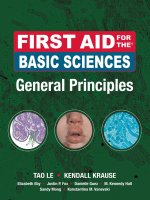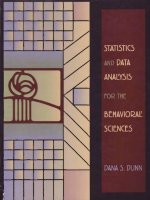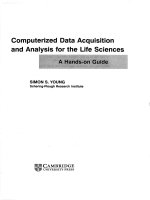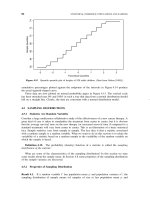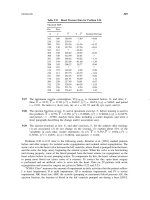Physical chemistry for the chemical sciences
Bạn đang xem bản rút gọn của tài liệu. Xem và tải ngay bản đầy đủ của tài liệu tại đây (2.52 MB, 991 trang )
University Science Books
www.uscibooks.com
Production Management: Jennifer Uhlich at Wilsted & Taylor
Manuscript Editing: John Murdzek
Design: Robert Ishi, with Yvonne Tsang at Wilsted & Taylor
Composition & Illustrations: Laurel Muller
Cover Design: Genette Itoko McGrew
Printing & Binding: Marquis Book Printing, Inc.
This book is printed on acid-free paper.
Copyright © 2014 by University Science Books
ISBN 978-1-891389-69-6 (hard cover)
ISBN 978-1-78262-087-7 (soft cover), only for distribution outside of North America and Mexico
by the Royal Society of Chemistry.
Reproduction or translation of any part of this work beyond that permitted by Section 107 or 108 of
the 1976 United States Copyright Act without the permission of the copyright owner is unlawful.
Requests for permission or further information should be addressed to the Permissions Department,
University Science Books.
Library of Congress Cataloging-in-Publication Data
Chang, Raymond.
Physical chemistry for the chemical sciences / Raymond Chang, John W. Thoman, Jr.
pages cm
Includes index.
ISBN 978-1-891389-69-6 (alk. paper)
1. Chemistry, Physical and theoretical—Textbooks. I. Thoman, John W., Jr., 1960–
QD453.3.C43 2014
541—dc23
2013038473
II. Title.
Printed in Canada
10 9 8 7 6 5 4 3 2 1
About the cover art: Tunneling in the quantum harmonic oscillator. The red horizontal
line represents the zero-point energy _1–2 hνi and the shaded region is the classically
forbidden region in which K0 , 0 ^see Chapter 11h.
www.pdfgrip.com
Preface
Physical Chemistry for the Chemical Sciences is intended for use in a one-year introductory course in physical chemistry that is typically offered at the junior level (the
third year in a college or university program). Students in the course will have taken
general chemistry and introductory organic chemistry. In writing this book, our aim is
to present the standard topics at the appropriate level with emphasis on readability and
clarity. While mathematical treatment of many topics is necessary, we have provided
a physical picture wherever possible for understanding the concepts. Only the basic
skills of differential and integral calculus are required for working with the equations.
The limited number of integral equations needed to solve the end-of-chapter problems
may be readily accessed from handbooks of chemistry and physics or software such
as Mathematica.
The 20 chapters of the text can be divided into three parts. Chapters 1–9 cover
thermodynamics and related subjects. Quantum mechanics and molecular spectroscopy are treated in Chapters 10–14. The last part (Chapters 15–20) describes chemical kinetics, photochemistry, intermolecular forces, solids and liquids, and statistical
thermodynamics. We have chosen a traditional ordering of topics, starting with thermodynamics because of the accessibility of the concrete examples and the closeness
to everyday experience. For instructors who prefer the “atoms first” or molecular
approach, the order can be readily switched between the first two parts without loss
of continuity.
Within each chapter, we introduce topics, define terms, and provide relevant
worked examples, pertinent applications, and experimental details. Many chapters
include end-of-chapter appendices, which cover more detailed derivations, background, or explanation than the body of the chapter. Each chapter concludes with a
summary of the most important equations introduced within the chapter, an extensive
and accessible list of further readings, and many end-of-chapter problems. Answers
to the even-numbered numerical problems may be found in the back of the book.
The end-of-book appendices provide some review of relevant mathematical concepts,
basic physics definitions relevant to chemistry, and thermodynamic data. A glossary
enables the student to quickly check definitions. Inside of the front and back covers,
we include tables of information that are generally useful throughout the book. The
second color (red) enables the student to more easily interpret plots and elaborate diagrams and adds a pleasing look to the book.
An accompanying Solutions Manual, written by Helen O. Leung and Mark D.
Marshall, provides complete solutions to all of the problems in the text. This supplement contains many useful ideas and insights into problem-solving techniques.
xv
www.pdfgrip.com
xvi
Preface
The lines drawn between traditional disciplines are continually being modified as
new fields are being defined. This book provides a foundation for further study at the
more advanced level in physical chemistry, as well as interdisciplinary subjects that
include biophysical chemistry, materials science, and environmental chemistry fields
such as atmospheric chemistry and biogeochemistry. We hope that you find our book
useful when teaching or learning physical chemistry.
It is a pleasure to thank the following people who provided helpful comments
and suggestions: Dieter Bingemann (Williams College), George Bodner (Purdue
University), Taina Chao (SUNY Purchase), Nancy Counts Gerber (San Francisco State
University), Donald Hirsh (The College of New Jersey), Raymond Kapral (University
of Toronto), Sarah Larsen (University of Iowa), David Perry (University of Akron),
Christopher Stromberg (Hood College), and Robert Topper (The Cooper Union).
We also thank Bruce Armbruster and Kathy Armbruster of University Science
Books for their support and general assistance. We are fortunate to have Jennifer
Uhlich of Wilsted & Taylor as our production manager. Her high professional standard and attention to detail greatly helped the task of transforming the manuscript
into an attractive final product. We very much appreciate Laurel Muller for her artistic
and technical skills in laying out the text and rendering many figures. Robert Ishi and
Yvonne Tsang are responsible for the elegant design of the book. John Murdzek did a
meticulous job of copyediting. Our final thanks go to Jane Ellis, who supervised the
project and took care of all the details, big and small.
Raymond Chang
John W. Thoman, Jr.
www.pdfgrip.com
Contents
Preface
CHAPTER
1
xv
Introduction and Gas Laws 1
1.1
1.2
1.3
1.4
Nature of Physical Chemistry 1
Some Basic Definitions 1
An Operational Definition of Temperature 2
Units 3
• Force 4
• Pressure 4
• Energy 5
• Atomic Mass, Molecular Mass, and the Chemical Mole 6
1.5 The Ideal Gas Law 7
• The Kelvin Temperature Scale 8
• The Gas Constant R 9
1.6 Dalton’s Law of Partial Pressures 11
1.7 Real Gases 13
• The van der Waals Equation 14
• The Redlich–Kwong Equation
• The Virial Equation of State 16
1.8 Condensation of Gases and the Critical State 18
1.9 The Law of Corresponding States 22
Problems 27
CHAPTER
2
Kinetic Theory of Gases 35
2.1 The Model 35
2.2 Pressure of a Gas 36
2.3 Kinetic Energy and Temperature 38
2.4 The Maxwell Distribution Laws 39
2.5 Molecular Collisions and the Mean Free Path 45
2.6 The Barometric Formula 48
2.7 Gas Viscosity 50
2.8 Graham’s Laws of Diffusion and Effusion 53
2.9 Equipartition of Energy 56
Appendix 2.1 Derivation of Equation 2.29 63
Problems 66
CHAPTER
3
3.1
3.2
3.3
The First Law of Thermodynamics 73
Work and Heat 73
• Work 73
• Heat 79
The First Law of Thermodynamics 80
Enthalpy 83
• A Comparison of ΔU and ΔH 84
www.pdfgrip.com
15
vi
Contents
3.4
3.5
A Closer Look at Heat Capacities 88
Gas Expansion 91
• Isothermal Expansion 92
• Adiabatic Expansion 92
3.6 The Joule–Thomson Effect 96
3.7 Thermochemistry 100
• Standard Enthalpy of Formation 100
• Dependence of Enthalpy of
Reaction on Temperature 107
3.8 Bond Energies and Bond Enthalpies 110
• Bond Enthalpy and Bond Dissociation Enthalpy 111
Appendix 3.1 Exact and Inexact Differentials 116
Problems 120
CHAPTER
4
The Second Law of Thermodynamics 129
4.1
4.2
Spontaneous Processes 129
Entropy 131
• Statistical Definition of Entropy 132
• Thermodynamic Definition of
Entropy 134
4.3 The Carnot Heat Engine 135
• Thermodynamic Efficiency 138
• The Entropy Function 139
• Refrigerators, Air Conditioners, and Heat Pumps 139
4.4 The Second Law of Thermodynamics 142
4.5 Entropy Changes 144
• Entropy Change due to Mixing of Ideal Gases 144
• Entropy Change
due to Phase Transitions 146
• Entropy Change due to Heating 148
4.6 The Third Law of Thermodynamics 152
• Third-Law or Absolute Entropies 152
• Entropy of Chemical
Reactions 155
4.7 The Meaning of Entropy 157
• Isothermal Gas Expansion 160
• Isothermal Mixing of Gases 160
• Heating 160
• Phase Transitions 161
• Chemical Reactions 161
4.8 Residual Entropy 161
Appendix 4.1 Statements of the Second Law of Thermodynamics 165
Problems 168
CHAPTER
5
5.1
5.2
5.3
5.4
5.5
5.6
Gibbs and Helmholtz Energies and Their Applications 175
Gibbs and Helmholtz Energies 175
The Meaning of Helmholtz and Gibbs Energies 178
• Helmholtz Energy 178
• Gibbs Energy 179
–
Standard Molar Gibbs Energy of Formation (ΔfG°) 182
Dependence of Gibbs Energy on Temperature and Pressure 185
• Dependence of G on Temperature 185
• Dependence of G on
Pressure 186
Gibbs Energy and Phase Equilibria 188
• The Clapeyron and the Clausius–Clapeyron Equations 190
• Phase Diagrams 192
• The Gibbs Phase Rule 196
Thermodynamics of Rubber Elasticity 196
www.pdfgrip.com
Contents
Appendix 5.1 Some Thermodynamic Relationships 200
Appendix 5.2 Derivation of the Gibbs Phase Rule 203
Problems 207
CHAPTER
6
Nonelectrolyte Solutions
213
6.1
Concentration Units 213
• Percent by Weight 213
• Mole Fraction ^xh 214
• Molarity ^Mh 214
• Molality ^mh 214
6.2 Partial Molar Quantities 215
• Partial Molar Volume 215
• Partial Molar Gibbs Energy 216
6.3 Thermodynamics of Mixing 218
6.4 Binary Mixtures of Volatile Liquids 221
• Raoult’s Law 222
• Henry’s Law 225
6.5 Real Solutions 228
• The Solvent Component 228
• The Solute Component 229
6.6 Phase Equilibria of Two-Component Systems 231
• Distillation 231
• Solid–Liquid Equilibria 237
6.7 Colligative Properties 238
• Vapor-Pressure Lowering 239
• Boiling-Point Elevation 239
• Freezing-Point Depression 243
• Osmotic Pressure 245
Problems 255
CHAPTER
7
Electrolyte Solutions 261
7.1
Electrical Conduction in Solution 261
• Some Basic Definitions 261
• Degree of Dissociation 266
• Ionic Mobility 268
• Applications of Conductance Measurements 269
7.2 A Molecular View of the Solution Process 271
7.3 Thermodynamics of Ions in Solution 274
• Enthalpy, Entropy, and Gibbs Energy of Formation of Ions in Solution 275
7.4 Ionic Activity 278
7.5 Debye–Hückel Theory of Electrolytes 282
• The Salting-In and Salting-Out Effects 286
7.6 Colligative Properties of Electrolyte Solutions 288
• The Donnan Effect 291
Appendix 7.1 Notes on Electrostatics 295
Appendix 7.2 The Donnan Effect Involving Proteins Bearing Multiple Charges 298
Problems 301
CHAPTER
8
8.1
8.2
Chemical Equilibrium 305
Chemical Equilibrium in Gaseous Systems 305
• Ideal Gases 305
• A Closer Look at Equation 8.7 310
• A Comparison of Δ rG° with Δ rG 311
• Real Gases 313
Reactions in Solution 315
www.pdfgrip.com
vii
viii
Contents
8.3
Heterogeneous Equilibria 316
• Solubility Equilibria 318
8.4 Multiple Equilibria and Coupled Reactions 319
• Principle of Coupled Reactions 321
8.5 The Influence of Temperature, Pressure, and Catalysts on the Equilibrium
Constant 322
• The Effect of Temperature 322
• The Effect of Pressure 325
• The Effect of a Catalyst 327
8.6 Binding of Ligands and Metal Ions to Macromolecules 328
• One Binding Site per Macromolecule 328
• n Equivalent Binding Sites
per Macromolecule 329
• Equilibrium Dialysis 332
Appendix 8.1 The Relationship Between Fugacity and Pressure 335
Appendix 8.2 The Relationships Between K1 and K 2 and the Intrinsic Dissociation
Constant K 338
Problems 342
CHAPTER
9
Electrochemistry 351
9.1
9.2
9.3
Electrochemical Cells 351
Single-Electrode Potential 353
Thermodynamics of Electrochemical Cells 356
• The Nernst Equation 360
• Temperature Dependence of EMF 362
9.4 Types of Electrodes 363
• Metal Electrodes 363
• Gas Electrodes 364
• Metal-Insoluble
Salt Electrodes 364
• The Glass Electrode 364
• Ion-Selective
Electrodes 365
9.5 Types of Electrochemical Cells 365
• Concentration Cells 365
• Fuel Cells 366
9.6 Applications of EMF Measurements 367
• Determination of Activity Coefficients 367
• Determination of pH 368
9.7 Membrane Potential 368
• The Goldman Equation 371
• The Action Potential 372
Problems 378
CHAPTER
10
Quantum Mechanics 383
10.1
10.2
10.3
10.4
10.5
10.6
10.7
10.8
10.9
Wave Properties of Light 383
Blackbody Radiation and Planck’s Quantum Theory 386
The Photoelectric Effect 388
Bohr’s Theory of the Hydrogen Emission Spectrum 390
de Broglie’s Postulate 397
The Heisenberg Uncertainty Principle 401
Postulates of Quantum Mechanics 403
The Schrödinger Wave Equation 409
Particle in a One-Dimensional Box 412
• Electronic Spectra of Polyenes 418
10.10 Particle in a Two-Dimensional Box 420
www.pdfgrip.com
Contents
10.11 Particle on a Ring 425
10.12 Quantum Mechanical Tunneling 428
• Scanning Tunneling Microscopy 431
Appendix 10.1 The Bracket Notation in Quantum Mechanics
Problems 437
CHAPTER
11
433
Applications of Quantum Mechanics to Spectroscopy 447
11.1
Vocabulary of Spectroscopy 447
• Absorption and Emission 447
• Units 448
• Regions of the
Spectrum 448
• Linewidth 449
• Resolution 452
• Intensity 453
• Selection Rules 455
• Signal-to-Noise Ratio 456
• The Beer–Lambert Law 457
11.2 Microwave Spectroscopy 458
• The Rigid Rotor Model 458
• Rigid Rotor Energy Levels 463
• Microwave Spectra 464
11.3 Infrared Spectroscopy 469
• The Harmonic Oscillator 469
• Quantum Mechanical Solution to
the Harmonic Oscillator 471
• Tunneling and the Harmonic Oscillator
Wave Functions 474
• IR Spectra 475
• Simultaneous Vibrational
and Rotational Transitions 479
11.4 Symmetry and Group Theory 482
• Symmetry Elements 482
• Molecular Symmetry and Dipole
Moment 483
• Point Groups 484
• Character Tables 484
11.5 Raman Spectroscopy 486
• Rotational Raman Spectra 489
Appendix 11.1 Fourier-Transform Infrared Spectroscopy 491
Problems 496
CHAPTER
12
Electronic Structure of Atoms 503
12.1
12.2
12.3
12.4
12.5
12.6
12.7
12.8
The Hydrogen Atom 503
The Radial Distribution Function 505
Hydrogen Atomic Orbitals 510
Hydrogen Atom Energy Levels 514
Spin Angular Momentum 515
The Helium Atom 517
Pauli Exclusion Principle 519
Aufbau Principle 523
• Hund’s Rules 524
• Periodic Variations in Atomic Properties
12.9 Variational Principle 530
12.10 Hartree–Fock Self-Consistent-Field Method 536
12.11 Perturbation Theory 540
Appendix 12.1 Proof of the Variational Principle 546
Problems 551
www.pdfgrip.com
528
ix
x
Contents
CHAPTER
13
Molecular Electronic Structure and the Chemical Bond
557
13.1
13.2
13.3
13.4
13.5
The Hydrogen Molecular Cation 557
The Hydrogen Molecule 561
Valence Bond Approach 563
Molecular Orbital Approach 567
Homonuclear and Heteronuclear Diatomic Molecules 570
• Homonuclear Diatomic Molecules 570
• Heteronuclear Diatomic
Molecules 573
• Electronegativity, Polarity, and Dipole Moments 576
13.6 Polyatomic Molecules 578
• Molecular Geometry 578
• Hybridization of Atomic Orbitals 579
13.7 Resonance and Electron Delocalization 585
13.8 Hückel Molecular Orbital Theory 589
• Ethylene ^C2H4h 590
• Butadiene ^C4H6h 595
• Cyclobutadiene ^C4H4h 598
13.9 Computational Chemistry Methods 600
• Molecular Mechanics ^Force Fieldh Methods 601
• Empirical and
Semi-Empirical Methods 601
• Ab Initio Methods 602
Problems 605
CHAPTER
14
Electronic Spectroscopy and Magnetic Resonance
Spectroscopy 611
14.1
Molecular Electronic Spectroscopy 611
• Organic Molecules 613
• Charge-Transfer Interactions 616
• Application of the Beer–Lambert Law 617
14.2 Fluorescence and Phosphorescence 619
• Fluorescence 619
• Phosphorescence 621
14.3 Lasers 622
• Properties of Laser Light 626
14.4 Applications of Laser Spectroscopy 629
• Laser-Induced Fluorescence 629
• Ultrafast Spectroscopy 630
• Single-Molecule Spectroscopy 632
14.5 Photoelectron Spectroscopy 633
14.6 Nuclear Magnetic Resonance Spectroscopy 637
• The Boltzmann Distribution 640
• Chemical Shifts 641
• Spin–Spin Coupling 642
• NMR and Rate Processes 644
• NMR of Nuclei Other Than 1H 646
• Solid-State NMR 648
• Fourier-Transform NMR 649
• Magnetic Resonance Imaging
^MRIh 651
14.7 Electron Spin Resonance Spectroscopy 652
Appendix 14.1 The Franck–Condon Principle 657
Appendix 14.2 A Comparison of FT-IR and FT-NMR 659
Problems 665
www.pdfgrip.com
Contents
CHAPTER
15
Chemical Kinetics 671
15.1
15.2
Reaction Rate 671
Reaction Order 672
• Zero-Order Reactions 673
• First-Order Reactions 674
• Second-Order Reactions 678
• Determination of Reaction Order 681
15.3 Molecularity of a Reaction 683
• Unimolecular Reactions 684
• Bimolecular Reactions 686
• Termolecular Reactions 686
15.4 More Complex Reactions 686
• Reversible Reactions 686
• Consecutive Reactions 688
• Chain Reactions 690
15.5 The Effect of Temperature on Reaction Rate 691
• The Arrhenius Equation 692
15.6 Potential-Energy Surfaces 694
15.7 Theories of Reaction Rates 695
• Collision Theory 696
• Transition-State Theory 698
• Thermodynamic Formulation of Transition-State Theory 699
15.8 Isotope Effects in Chemical Reactions 703
15.9 Reactions in Solution 705
15.10 Fast Reactions in Solution 707
• The Flow Method 708
• The Relaxation Method 709
15.11 Oscillating Reactions 712
15.12 Enzyme Kinetics 714
• Enzyme Catalysis 715
• The Equations of Enzyme Kinetics 716
• Michaelis–Menten Kinetics 717
• Steady-State Kinetics 718
• The Significance of K M and Vmax 721
Appendix 15.1 Derivation of Equation 15.9 724
Appendix 15.2 Derivation of Equation 15.51 726
Problems 731
CHAPTER
16
16.1
16.2
16.3
16.4
Photochemistry 743
Introduction 743
• Thermal Versus Photochemical Reactions 743
• Primary Versus
Secondary Processes 744
• Quantum Yields 744
• Measurement of
Light Intensity 746
• Action Spectrum 747
Earth’s Atmosphere 748
• Composition of the Atmosphere 748
• Regions of the
Atmosphere 749
• Residence Time 750
The Greenhouse Effect 751
Photochemical Smog 754
• Formation of Nitrogen Oxides 755
• Formation of O3 755
• Formation of Hydroxyl Radical 756
• Formation of Other
Secondary Pollutants 757
• Harmful Effects and Prevention of
Photochemical Smog 757
www.pdfgrip.com
xi
xii
Contents
16.5
Stratospheric Ozone 759
• Formation of the Ozone Layer 759
• Destruction of Ozone 760
• Polar Ozone Holes 762
• Ways to Curb Ozone Depletion 763
16.6 Chemiluminescence and Bioluminescence 764
• Chemiluminescence 764
• Bioluminescence 765
16.7 Biological Effects of Radiation 766
• Sunlight and Skin Cancer 766
• Photomedicine 767
• Light-Activated Drugs 768
Problems 774
CHAPTER
17
Intermolecular Forces
779
17.1
17.2
17.3
Intermolecular Interactions 779
The Ionic Bond 780
Types of Intermolecular Forces 782
• Dipole–Dipole Interaction 782
• Ion–Dipole Interaction 784
• Ion–Induced Dipole and Dipole–Induced Dipole Interactions 785
• Dispersion, or London, Interactions 788
• Repulsive and Total
Interactions 789
17.4 Hydrogen Bonding 791
17.5 The Structure and Properties of Water 796
• The Structure of Ice 797
• The Structure of Water 798
• Some Physiochemical Properties of Water 800
17.6 Hydrophobic Interaction 801
Problems 806
CHAPTER
18
The Solid State
809
18.1
18.2
18.3
Classification of Crystal Systems 809
The Bragg Equation 812
Structural Determination by X-Ray Diffraction 814
• The Powder Method 816
• Determination of the Crystal Structure of
• The Structure Factor 820
• Neutron Diffraction 822
NaCl 817
18.4 Types of Crystals 823
• Metallic Crystals 823
• Ionic Crystals 829
• Covalent
Crystals 834
• Molecular Crystals 835
Appendix 18.1 Derivation of Equation 18.3 836
Problems 840
CHAPTER
19
19.1
19.2
19.3
19.4
The Liquid State 843
Structure of Liquids 843
Viscosity 845
• Blood Flow in the Human Body 848
Surface Tension 851
• The Capillary-Rise Method 852
• Surface Tension in the Lungs
Diffusion 856
• Fick’s Laws of Diffusion 857
www.pdfgrip.com
854
Contents
19.5
Liquid Crystals 863
• Thermotropic Liquid Crystals 864
• Lyotropic Liquid Crystals
Appendix 19.1 Derivation of Equation 19.13 869
Problems 872
CHAPTER
20
868
Statistical Thermodynamics 875
20.1
20.2
20.3
The Boltzmann Distribution Law 875
The Partition Function 878
Molecular Partition Function 881
• Translational Partition Function 881
• Rotational Partition
Function 883
• Vibrational Partition Function 884
• Electronic
Partition Function 886
20.4 Thermodynamic Quantities from Partition Functions 886
• Internal Energy and Heat Capacity 887
• Entropy 888
20.5 Chemical Equilibrium 893
20.6 Transition-State Theory 898
• Comparison Between Collision Theory and Transition-State Theory 900
Appendix 20.1 Justification of Q 5 qN/N! for Indistinguishable Molecules 903
Problems 905
Appendix A Review of Mathematics and Physics 907
Appendix B Thermodynamic Data 917
Glossary 923
Answers to Even–Numbered Computational Problems 937
Index 941
www.pdfgrip.com
xiii
chapter
1
Introduction and Gas Laws
And it’s hard, and it’s hard, ain’t it hard, good Lord.
— Woody Guthrie*
1.1 Nature of Physical Chemistry
Physical chemistry can be described as a set of characteristically quantitative
approaches to the study of chemical problems. A physical chemist seeks to predict
and/or explain chemical events using certain models and postulates.
Because problems encountered in physical chemistry are diversified and often
complex, they require a number of different approaches. For example, in the study
of thermodynamics and rates of chemical reactions, we employ a phenomenological, macroscopic approach. But a microscopic, molecular approach based on quantum
mechanics is necessary to understand the kinetic behavior of molecules and reaction
mechanisms. Ideally, we study all phenomena at the molecular level, because it is here
that change occurs. In fact, our knowledge of atoms and molecules is neither extensive
nor thorough enough to permit this type of investigation in all cases, and we sometimes have to settle for a good, semiquantitative understanding. It is useful to keep in
mind the scope and limitations of a given approach.
1.2 Some Basic Definitions
Before we discuss the gas laws, it is useful to define a few basic terms that will be used
throughout the book. We often speak of the system in reference to a particular part of
the universe in which we are interested. Thus, a system could be a collection of helium
molecules in a container, a NaCl solution, a tennis ball, or a Siamese cat. Having defined
a system, we call the rest of the universe the surroundings. There are three types of
systems. An open system is one that can exchange both mass and energy with its surroundings. A closed system is one that does not exchange mass with its surroundings
but can exchange energy. An isolated system is one that can exchange neither mass nor
energy with its surroundings ^Figure 1.1h. To completely define a system, we need to
understand certain experimental variables, such as pressure, volume, temperature, and
composition, which collectively describe the state of the system.
* “Hard, Ain’t It Hard.” Words and Music by Woody Guthrie. TRO-© Copyright 1952
Ludlow Music, Inc., New York, N.Y. Used by permission.
www.pdfgrip.com
A system is separated from
the surroundings by a
definite boundary, such as
walls or surfaces.
1
www.pdfgrip.com
www.pdfgrip.com
www.pdfgrip.com
www.pdfgrip.com
www.pdfgrip.com
www.pdfgrip.com
www.pdfgrip.com
www.pdfgrip.com
www.pdfgrip.com
www.pdfgrip.com
www.pdfgrip.com

